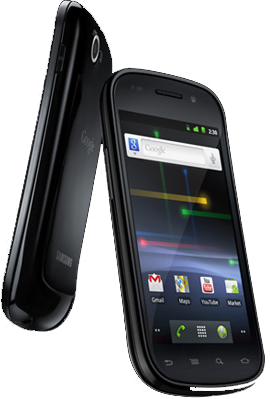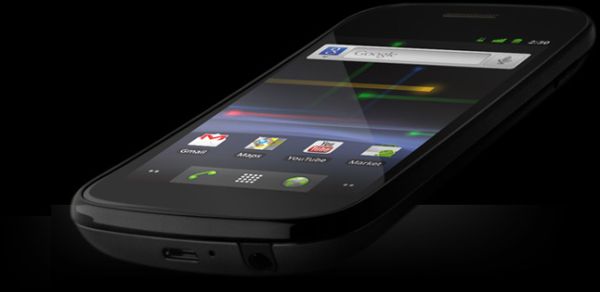A Busy Day for Android - Nexus S and Gingerbread (2.3) Officially Announced
by Brian Klug on December 6, 2010 9:35 PM EST- Posted in
- Smartphones
- Nexus S
- Android
- Mobile
Developer Features
Gingerbread brings a number of developer features and API changes, most notably, improvements to the Dalvik VM garbage collector and event distributor. Google promises smoother gaming with fewer application pauses as a result of the concurrent garbage collection in Gingerbread, and hopefully some of Android's occasional UI stutters will be fixed as a result - the target is to have sub 3ms pauses while Dalvik garbage collects. There are also updated video drivers which improve OpenGL ES performance for faster 3D graphics, but it's unclear which GPUs will get updated drivers. Gingerbread also brings along a Linux kernel update, from 2.6.32 on Android 2.2.1 to 2.6.35 in Gingerbread 2.3.
Gingerbread adds Khronos OpenSL ES sound APi support, and Khronos EGL support for better OpenGL ES texture, surface, and context support. The other changes for developers include better APIs for native input from sensors and adds support for a few more: gyroscope, rotation vector, linear acceleration, gravity, and even barometer sensors are supported. I'd definitely like to see a smartphone with a barometric sensor, given how inaccurate even WAAS-supported GPS is at reporting altitude properly.

The camera API also has been updated to allow for better support for devices with multiple cameras, most notably devices with a front-facing camera.
Finally Google has added VP8 video compression support and WebM container support, Google's own compression standards. There's also new AAC encoding and AMR Wideband encoding for audio capture.
Nexus S
Alongside the Gingerbread software update news came announcement of a new Google-branded device we've already seen a of photos and sneak peaks of, including from Eric Schmidt himself - the Nexus S.

Unlike the Nexus One, Google will not be selling the Nexus S directly, but rather unlocked through Best Buy stores in the US and at Carphone Warehouse in the UK. US availability will start December 16th, and December 20th for the UK. Pricing will start at $529 unlocked and $199 on two-year contract with T-Mobile. The Nexus S has tri-band HSPA support for 900, 2100, and 1700 MHz bands, which means it has 3G support for T-Mobile in the US - AT&T users will see EDGE.
| Nexus S - Network Support | |||||
| Tri-Band HSPA | 900 / 1700 / 2100 MHz | ||||
| Quad-Band GSM/EDGE | 850 / 900 / 1800 / 1900 MHz | ||||
| HSDPA/HSUPA | 7.2Mbps / 5.76Mbps | ||||
The Nexus S is speced similar to the Samsung Galaxy S line of devices - there's a 1 GHz Hummingbird SoC with Imagination SGX540 graphics, 16 GB NAND, 512 MB RAM, 802.11b/g/n, 4" Super AMOLED display, and the usual sensors.
| Physical Comparison | |||||||||
| Apple iPhone 4 | Motorola Droid 2 | Samsung Galaxy S Fascinate | Samsung Focus | Google Nexus S | |||||
| Height | 115.2 mm (4.5") | 116.3 mm (4.6") | 125 mm (4.92") | 122.9 mm (4.84") | 123.9 mm (4.88") | ||||
| Width | 58.6 mm (2.31") | 60.5 mm (2.4") | 64.2 mm (2.53") | 65 mm (2.56") | 63.0 mm (2.48") | ||||
| Depth | 9.3 mm ( 0.37") | 13.7 mm (0.54") | 9.91 mm (0.39") | 9.9 mm (0.39") | 10.88 mm (0.43") | ||||
| Weight | 137 g (4.8 oz) | 169 g (5.9 oz) | 117 grams (4.16 oz) | 119 grams (4.2 oz) | 129 grams (4.6 oz) | ||||
| CPU | Apple A4 @ ~800MHz | Texas Instruments OMAP 3630 @ 1 GHz | 1 GHz Samsung Hummingbird | 1 GHz Qualcomm QSD8250 | 1 GHz Samsung Hummingbird | ||||
| GPU | PowerVR SGX 535 | PowerVR SGX 530 | PowerVR SGX 540 | Adreno 200 | PowerVR SGX 540 | ||||
| RAM | 512MB LPDDR1 (?) | 512 MB LPDDR1 | 512 MB LPDDR1 | 512 MB LPDDR1 (?) | 512 MB LPDDR1 | ||||
| NAND | 16GB or 32GB integrated | 8 GB integrated, preinstalled 8 GB microSD | 2 GB, 16 GB microSD (Class 2) | 16 GB integrated | 16 GB Integrated | ||||
| Camera | 5MP with LED Flash + Front Facing Camera | 5 MP with dual LED flash and autofocus | 5 MP with auto focus and LED flash | 5 MP with autofocus, LED flash, 720P video recording | 5 MP with Autofocus, LED Flash, VGA front facing, 720P Video | ||||
| Screen | 3.5" 640 x 960 LED backlit LCD | 3.7" 854 x 480 | 4" Super AMOLED 800 x 480 | AMOLED 800 x 480 4" | 4" Super AMOLED 800 x 480 | ||||
Where the Nexus S differs is the inclusion of a front facing VGA camera in addition to back 5 MP camera, LED Flash, three-axis gyroscope, inclusion of Bluetooth 2.1+EDR (instead of Bluetooth 3.0 as with Galaxy S), and new hardware onboard for NFC support. It's possible the NFC hardware is integrated into the Bluetooth chipset which would explain the discrepancy, but it's too early to tell.
The Nexus S packs 16 GB of NAND onboard, a large portion of which is partitioned for storage, emulating a microSD card. Gingerbread brings official platform support for devices that lack external storage, instead allowing for internal NAND to be partitioned to emulate a virtual SD card. That appears to be what is done on the Nexus S - there’s no microSD card - but this also has the potential to result in applications loaded to the virtual SD card feeling much snappier than they would be loaded on most microSD cards. I've noticed that even on my Nexus One with a fast class 6 card that applications seem to behave slower on external storage.
What's notable about the Nexus S display is that it is slightly curved. Whereas the Dell Venue Pro has a noticeable convex display in the horizontal dimension, the Nexus S has a subtle but perceptible vertical concave curve. I'm reminded of the Palm Pre's "ergonomic curve" with the Nexus S. In addition, Google notes that the Nexus S definitely has an anti-fingerprint coating.
Of course, the Nexus S ships with Gingerbread installed by default, and takes the Nexus One’s place as the reference device for the Android platform. As usual, expect a full review after we get ours.












45 Comments
View All Comments
TareX - Monday, December 6, 2010 - link
Where do I start.... the plastic case with the ugly bump at the back? The SINGLE CORE A8 PROCESSOR, in 2011? No microDS expansion? No LED notifications?GB also disappointed, massively: No multimedia app, no Gmail video chat, no UI GPU acceleration, no tabbed browsing as rumored...etc
The only impressive thing is the curved Super AMOLED with insane contrasts. That's it.
Let's hope the Olympus has a comparable screen.
bplewis24 - Tuesday, December 7, 2010 - link
You say no UI GPU acceleration, but Brian states the following:"Gingerbread’s UI brings GPU accelerated animations onboard and will likely provide some speedup to the interface."
Is that different from what you were referring to?
Brandon
thernus - Tuesday, December 7, 2010 - link
GPU accelerated UI was one of the features i really wanted with 2.3 (hell i wanted it with 2.1 on my nexus one.this article is the only one i have seen talking about it.
Brian can you please clarify this? watching the video clips they talk about the garbage collection for apps and the GPU stuff games im really hoping there is a noticable speed increase
its really stupid in this day and age that android doesnt have it. Apple has is winmo7 has it, palm finally might get it after more than a year of promising (I had a pre and it was way to small and laggy i actually gave it away!)
if android doesnt get it soon im jumping back to a iphone or going over to a winmo7 phone when i look to get another phone in 6months time the jittery lag on the N1 kills the experience to much.
Brian Klug - Tuesday, December 7, 2010 - link
At this point, it's a bit unclear. There's definitely GPU acceleration for most animations now, and the UI in general is supposed to be much smoother. I'm not clear yet on whether all of the UI is 100% GPU accelerated, for that I'm waiting to get a device in-hand.I'm just uncertain how much of this menu smoothness is attributable to the Dalvik VM doing much faster/opportune garbage collection (which Google is claiming was responsible for a lot of that trademark Android stuttering when just scrolling through menus or webpages), and how much of that will be sped up purely from having a leaner UI with more GPU accelerated animations.
Stay tuned, I'm going to try and find out.
-Brian
tipoo - Saturday, December 11, 2010 - link
"The SINGLE CORE A8 PROCESSOR, in 2011? "Wut? Are there any smartphones using a dual core processor right now? Yeah, dual core A9's are right around the corner, but phones are in development for months before release.
bplewis24 - Tuesday, December 7, 2010 - link
"long-press to select accented characters (which sounds almost identical to iOS's implementation)"Android has had that since at least 2.1, if not sooner.
Brandon
MacTheSpoon - Tuesday, December 7, 2010 - link
That's weird. Samsung's numbers are off. Verizon lists the specs as 4.92" (H) x 2.53" (W) x 0.39" (D). I pulled out my ruler and Verizon is right; the Fascinate is actually nearly 5" tall. Verizon also gives the weight as 4.16 oz., or 118 grams, which is a good ten grams less than Samsung's number. I'm guessing Verizon is right about the weight as well, because my Fascinate has to be more than 10 grams lighter than the iPhone 4s I've used.Brian Klug - Tuesday, December 7, 2010 - link
Indeed, I think you're right in that regard. I just measured this Fascinate and it appears to be at least 4.875" tall. I'll update the article+dimensions. Awesome catch!-Brian
rigamortis - Tuesday, December 7, 2010 - link
I bought the nexus one when it first came out , i was so excited. Then i slowly started to realize that T-mobile kills the phone. The single worst carrier on the planet. I could go on for days on this since my wife and their parents have the family plan. I went back to sprint. Love the phone, hate T-mobile and ATT.eVo 4G owner
MacTheSpoon - Tuesday, December 7, 2010 - link
Thanks for being responsive to reader feedback, Brian! You rock.